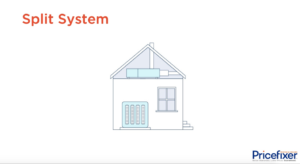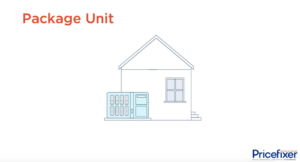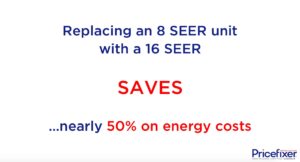SEER Options You Should Definitely Check Out and Energy Efficiency Standards from the Government
It’s easy to take your air conditioner for granted. You likely never give it a moment’s thought as it hums quietly in the background cooling your home to the perfect temperature on those sweltering hot days… until suddenly it doesn’t. Next thing you know you’re on the phone with an AC company who asks you what type of system you have, and all you know is it’s an “air conditioner” – you have no idea what kind of unit it is. Well, if you’re in the market for replacing your old air conditioner, then it’s time to educate yourself about an important component of your home that’s integral to your comfort, well-being and wallet.
Let’s cover the basic parts of a central air conditioning system, how it functions to cool the air, the ever-important SEER energy rating every new AC unit has, and how to find the perfect AC system for your home.
Central air conditioning systems come in three types: split systems, packaged units and ductless systems. Let’s just look at split and packaged for now. Split systems have two separate parts; one part located outside the home that contains the condensing unit and compressor, and one part located inside the home containing an evaporator coil. A packaged unit has the condenser, compressor and evaporator coil located in one single unit that typically sits outside the home on the roof or on a slab next to the foundation.
Split System vs Packaged Unit
Split and packaged systems both work the same way, however, there are some differences. For example, split systems are much larger than packaged units, are typically cheaper to repair and maintain, and come with higher energy-efficiency SEER ratings. Packaged units are typically cheaper to install because there’s just one piece, but exposure to the outside elements could cause damage or a shortened life span, and they have lower energy-efficiency SEER ratings.
Split System:

- Much larger than packaged units
- Typically cheaper to repair and maintain
- Available in higher SEER-rated models
Packaged System:

- Cheaper to install
- Exposure to the outside elements could cause damage
- Lower energy-efficiency SEER ratings
The deciding factor as to whether a split system or a package unit is the best one for you is largely dependent on the layout and size of your home. A good rule of thumb, though, is to stay consistent with what you already have and replace a split system with a split system and a packaged unit with a packaged unit, especially if you have been generally satisfied with the level of comfort your system provides.
To discover more about the different types of systems, click here to watch a video explainer designed just for you.
How Air Conditioners Work
Air conditioners use refrigerants to cool indoor air by drawing the warm air out of your home through ducts, and supplying cool air through the registers and vents in the ceilings or floors. Besides cooling the indoor air, air conditioners also regulate the ambient temperature of the home via a thermostat. Additionally, they act as dehumidifiers, because reducing the temperature of humid air reduces its moisture content, and air filtration systems as they remove airborne particles from the circulating air through the use of filters. That’s quite a lot going on for one air conditioner!
What’s even more impressive is how the components of an air conditioner, the coils, condenser, compressor, fans, and blower, replicate the physical law of when a liquid converts to a gas, it absorbs heat (known as phase conversion) in order to generate cooling. Warm air moves over refrigerant-filled coils, causing the refrigerant to evaporate from a liquid to a gaseous state – absorbing heat as it does so – and then it is compressed and condensed back into a liquid state for the process to begin all over again. The chilled air is then circulated throughout your house by blowers located in the air handling unit.
Some useful terms are included on the Cooling Cheat Sheet below.

New Air Conditioning Systems Can Save You Money
Air conditioners certainly have come a long way since the first system was developed by Willis Carrier in 1902. The device he created blew air across chilled pipes to lower the temperature and humidity levels. Today’s air conditioning systems effectively and efficiently cool your home by using state-of-the-art equipment that uses a lot less energy than the models produced just a few years ago do.
In fact, there’s a good number of energy-efficient AC models to choose from now, ranging from 13 SEER all the way to 26 SEER, with higher-rated models being manufactured every year. SEER stands for Seasonal Energy Efficiency Ratio and indicates the energy-efficiency of a particular air conditioning system. The higher the SEER rating, the more energy-efficient it is, which means increased savings on your utility bill over the life of the air conditioner. Although more expensive than base models, you can usually recoup the extra cost of purchasing a high SEER unit over several years by the lower monthly utility bills you’ll receive. Most commonly, people gravitate toward the 14-18 SEER range when purchasing equipment for their home.
If your current air conditioner has been around awhile and showing signs of needing repair, such as not cooling your home like it should on hot, summer days, skyrocketing utility bills, or clanking, banging, or rattling sounds, then it’s probably time to start shopping for a replacement. The good news is that depending on the SEER rating of your current system, newer SEER models can save you a lot of money on your energy bill! If your current air conditioner is pretty ancient, then it could be an 8 SEER. Replacing it with a 16 SEER unit would save you nearly 50% on energy costs and significantly reduce your utility bill.

How to Find Your AC Unit’s SEER Rating
To find out the SEER rating of your current split system unit, look for the yellow and black tag stuck to the side of the condenser. You will see the words “Seasonal Energy Efficiency Ratio” and the number underneath is the SEER number. If you can’t find it there, look for a performance information sheet stuck to the front of the air handler on the indoor part of the unit. Most packaged units have the SEER rating listed on the black and yellow “hang tag” located on the outside of the unit. If you’ve looked everywhere and still can’t find your SEER rating, then the Air Conditioning, Heating and Refrigeration Institute has a handy directory look up on their website here, where you can put in the make and model of your AC system to find the SEER rating.
Now that you know your current system’s SEER number, you can calculate how much more energy efficient your new air conditioner will be. Chances are, your old unit has a SEER rating that is no longer made or allowed to be made by law. In 2015, the Department of Energy (DOE) mandated that all new air conditioners manufactured in the U.S. be a minimum of 13 SEER for northern states and minimum of 14 SEER for southeastern and southwestern states.
Use the link below to see the SEER Minimums map and discover the government requirements for your state.
Why Having an Energy Efficient Air Conditioner Is Important
The U.S. Department of Energy implemented energy conservation standards for air conditioners, and other appliances we typically use on a daily basis, to help save consumers billions of dollars each year and to reduce harmful effects on the environment caused by our energy consumption. According to the DOE’s website, three-quarters of all homes in the U.S. have air conditioners which use close to 6% of all the electricity produced in the United States, costing homeowners $29 billion annually. As a result, about 117 million metric tons of carbon dioxide are released into the air each year.
This is a serious concern because carbon dioxide (CO2) is a greenhouse gas that traps heat within the Earth’s atmosphere (for decades, if not centuries!) and contributes more to global warming and climate change than any other green house gas. More and more extreme weather events are being linked to climate change, and the effects of climate change are far-reaching: from rising temperatures causing a shift in precipitation patterns that change the growing patterns of plants threatening wildlife dependent on this source of food, to rising sea levels eroding shorelines and destroying ecosystems, to farms and crops producing lower yields resulting in significant economic losses.
So, limiting CO2 emissions is imperative for protecting the environment and minimizing climate change. Do your part to reduce your carbon footprint by minimizing the amount of energy you waste as much as possible. Switch to energy efficient light bulbs, walk or ride your bike instead of driving a car, take shorter showers, and install an energy-efficient air conditioning system with a high SEER rating.
Questions to Ask Before Purchasing Your New Air Conditioning System
Now that you’ve determined you’re upgrading your current air conditioning system with a more energy-efficient one, and you’ve educated yourself about the different types of central air conditioning systems, there are some important questions you should ask your contractor before your new unit is installed, such as:
- What size system do I need to adequately cool my home? Don’t assume the size of the old system is the right size as it may not have been measured properly.
- Will the current ductwork suffice? What is the condition of the current ductwork; should the ductwork be cleaned before the new unit is installed?
- Are there any rebates, tax credits, or savings incentives for purchasing an energy-efficient system?
- What kind of regular maintenance is required? Do you offer a maintenance program?
- What type of warranty is there and what does it cover?
With a little bit of AC knowledge and asking the right questions, you will be able to make the best choice in air conditioning systems for your home.
